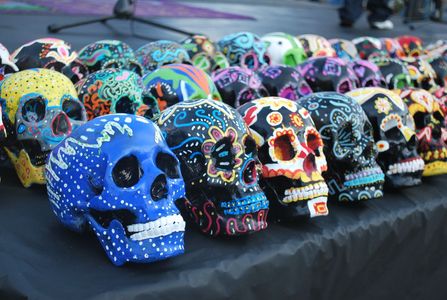
Si buscas
hosting web,
dominios web,
correos empresariales o
crear páginas web gratis,
ingresa a
PaginaMX
Por otro lado, si buscas crear códigos qr online ingresa al Creador de Códigos QR más potente que existe


Called All-hallows or All-hallowmas (from Middle English Alholowmesse meaning All Saints' Day) and the night before it, the traditional night of Samhain in the Celtic religion, began to be called All-hallows Eve and, eventually, Halloween.
2. Describe at least 3 superstitions related to this festivity.
It was believed that ghosts came back to the earthly world, people thought that they would encounter ghosts if they left their homes. To avoid being recognized by these ghosts, people would wear masks when they left their homes after dark so that the ghosts would mistake them for fellow spirits.
It was believed to keep ghosts away from their houses, people would place bowls of food outside their homes to appease the ghosts and prevent them from attempting to enter.
Avoid crossing paths with black cats, afraid that they might bring us bad luck.
3. Why do we carve pumpkins for Halloween?
Because people say pumpkins scared ghosts other people say that pumpkins help jacks soul.
4. Explain how to cook a typical Halloween dish.
Jack-o'-Lantern Oranges Recipe
Ingredients
• 8 small navel oranges
• 1 small apple, chopped
• 1/2 cup halved seedless red grapes
• Slivered almonds and whole cloves
Directions
• Choose which side of each orange will be the jack-o'-lantern's face; cut a thin slice from the bottom of each so that it rests flat. Cut another small slice from the top. Spoon out pulp. Chop pulp and combine with apple and grapes; set aside.
• Cut faces as desired; decorate with cloves and almonds. Spoon fruit mixture into jack-o'-lanterns.
5. What’s the origin of the celebration Day of the Dead?
It was created by Mesoamerican civilizations they all shared a common thread they belief in the afterlife. When people died, they didn't cease to exist instead, their soul carried on to the afterworld. Then with the Spaniards conquered the Aztecs in 1521 The Spanish convinced the indigenous people to attend special masses on those two days to commemorate the dead, as they tried to shift the original Dia de los Muertos history and meaning to suit their own Catholic purpose.
6. What does Day of the Dead traditions consist on?In homes, people create altars to honor their deceased loved ones. In some places it is common to allow guests to enter the house to view the altar decorate with food, candies, photos, flowers and incense.
In graveyards, families clean the graves of their loved ones, which they then decorate with flowers, photos, candies, foods and drinks. Some people stay up all night in the graveyards, socializing and telling funny stories about their dead ancestors.
Musicians are hired to stroll through the graveyard, playing the favorite songs of the dead.
7. Which elements should an altar have?
Food, candies, dishes, photos, flowers, incense, salt, chocolate and sugar skulls, water, drinks.
8. What is the meaning of each of these elements?
• Candles - Candles are lit to welcome the spirits back to their altars.
• Marigolds - These yellow-orange flowers, also called cempasúchitl, symbolize death. Their strong fragrance also helps lead the dead back to their altars. Marigold petals may also be sprinkled on the floor in front of the altar, or even sprinkled along a path from the altar to the front door, so that the spirit may find her way inside.
• Incense - Most commonly, copal incense, which is the dried aromatic resin from a tree native to Mexico. The scent is also said to guide the spirits back to their altars
• Salt - represents the continuance of life.
• Photo of the deceased - A framed photo of the dead person to whom the altar is dedicated, usually positioned in a prime spot on the altar.
• Pan de muerto - Also known as "bread of the dead", pan de muerto is a symbol of the departed.
• Sugar skulls - As symbols of death and the afterlife, sugar skulls are not only given as gifts to the living during Day of the Dead, they are also placed as offerings on the altar.
• Fresh fruit - whatever is in season – oranges, bananas, etc.
• Water - Souls are thirsty after their long journey from the Other Side, so they appreciate a glass of water upon arrival.
• Toiletries - Likewise, the spirit will want to freshen up after they reach the altar, so a hairbrush, a mirror and some soap are always appreciated, along with a small towel.
• Images of saints - or other role models who were important in the dead person's life.
• Papel picado - These decorative pieces of cut paper are draped around the altar's edge or hung from above.
• Ceramics and woven baskets - were traditionally included in Day of the Dead altars.
9. What are the main symbols of Day of the Dead?
• Skulls: symbolize death and rebirth
• Skeletons (catrinas): poke sarcastic fun at how death is the great equalizer even the rich can't escape from death!
• Marigolds: flowers are a symbol of death.
• Pan de muerto: symbolizes the souls of the departed.
• Papel picado: is a popular Day of the Dead decoration. Papel picado refers to colorful tissue paper that is cut with elaborate designs that depict the holiday spirit.
04282